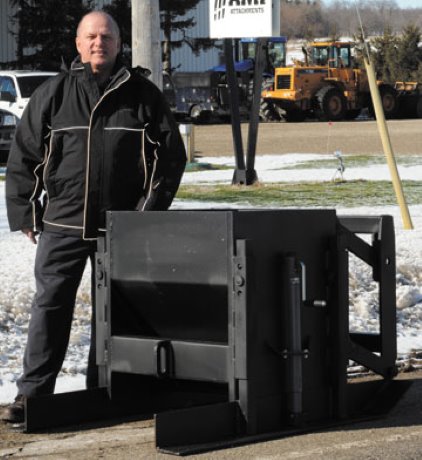Thoughts of safety and efficiency beget innovation for Doug Bergman, who still recalls a memorable day, which led to his current business venture and invention.
Innovation
Thoughts of safety and efficiency beget innovation for Doug Bergman, who still recalls a memorable day, which led to his current business venture and invention.
Bergman recounted a recent trip watching road crews on Highway 401 edging the busy roadway.
“I was heading west, and they were on the eastern side. There were six to eight people working on the crew, and just behind the crash truck I saw a car wedged underneath the crash bar,” he said.
“The danger of working on the road like that just blew me away. There’s no reason for workers to be out there in the open, exposing themselves to danger and twisting and turning in the hot sun, when you can do both edging and potholing from inside the cab.”
Bergman’s solution is the Pavement Edger, an invention he conceived about 10 years ago to take the manual labour out of edging and pothole filling.
The device, patented in Canada and the U.S., is a steel hopper that can be easily retrofitted to municipal salting or sanding trucks.
“Using existing snowplow hydraulics and quick-connect fittings, the box drops asphalt onto the edge of the road or into potholes, and the rear wheels of the truck pack the asphalt down as it passes,” said Bergman.
“It takes only one person in the truck to do road edging — no windrows, hand tools or manual work required. You can set up a mirror and cameras to fill potholes, or you can take along a wing man to watch the pothole operation on the passenger’s side.”
It takes about two days to retrofit an existing vehicle. After that, it takes two workers about 10 minutes to mount or unmount the unit.
In operation, the hopper is designed to follow the road, not the truck chassis and the feed hopper provides an even supply of material, regardless of truck speed.
“We clocked the performance for a unit sold to Wellesley Township and laid down 900 feet of pavement edging in seven minutes,” he said.
Bergman originally came up with the concept for a pavement edger in 1998, but found it was easily adapted to patching potholes as well.
He financed development of the product and farmed out manufacturing to AMI Attachments of Floradale, Ontario.
In 2001, he founded MD Roadsavers, a company designed to market the product.
Sales were respectable, but didn’t achieve the breakthrough level Bergman wanted.
“We’ve sold about 100 units to municipalities so far,” he said.
“Where it’s caught on, it’s caught on big.”
Bergman’s biggest sales so far are in New Brunswick.
“After a two-day meeting with provincial road officials, they put the Pavement Edger to the test and I recommended they put two units in each of their eight districts,” he said. “They bought 40 instead.”
Each unit currently sells for about $5,300.
“That’s cheap when you consider that a brake job on a tandem truck can cost you $6,000,” he said.
Bergman has recently expanded his marketing efforts by teaming up with a North American distributor with established sales agents across Canada — AMI Attachments, the same company that’s been manufacturing the unit.
“I was retrofitting a truck for the City of Kitchener and Steve Frey, the president, helped me with the installation,” Bergman said.
“It was the first time he’d seen it in operation and he was excited. He asked me if he could distribute it along with his other products, as a unique attachment that would help generate interest in the market when he promotes his entire line.”
Bergman said some road superintendents have told him they’ve never again filled a pothole in the traditional way after using his invention.
“Although it reduces manual labour, it’s never been about replacing workers,” he said.
“The biggest complaint in most road departments is that they don’t have enough workers to go around. This will free them to do other work that needs to be done.”











Recent Comments
comments for this post are closed